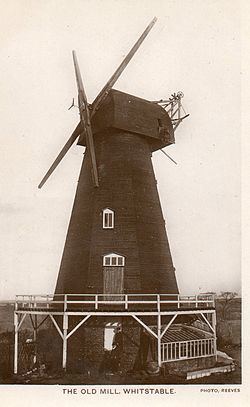Mill location TR 105 652 Base storeys Single-storey base Year built 1815 | Purpose Corn mill Storeys Four-storey smock Smock sides Eight-sided | |
 | ||
Similar Starston Windpump, Caston Windmill, Great Mill - Sheerness, Chalton Windmill, Bragg's Mill - Ashdon | ||
Black Mill, or Borstal Hill Mill is a smock mill in Whitstable, Kent, England that was built in 1815. It is now a part of a private residence at the end of Millers Court.
Contents
History
Black Mill was built in 1815. A mill that previously stood on the site was marked on Bowen's map of 1736. The mill had been painted white when built, but was tarred in 1885, thus gaining its name of Black Mill. Trinity House had to be notified, as the mill was a navigational landmark for sailors. The mill last worked circa 1905 and in 1928 was converted into a studio by the artist Laurence Irving, the grandson of Sir Henry Irving. The mill was later converted into a motel. The converted tower still contains the major milling machinery, and externally bears stocks and a dummy fantail.
Description
Black mill is a four-storey smock mill on a single-storey brick base. There was a stage at first-floor level. It had four patent sails carried on a cast-iron windshaft. The Brake wheel survives. This drove a cast-iron Wallower mounted on a wooden Upright Shaft. The Great Spur Wheel also survives. The mill drove three pairs of millstones overdrift. It was winded by a fantail.
Millers
References for above:-
